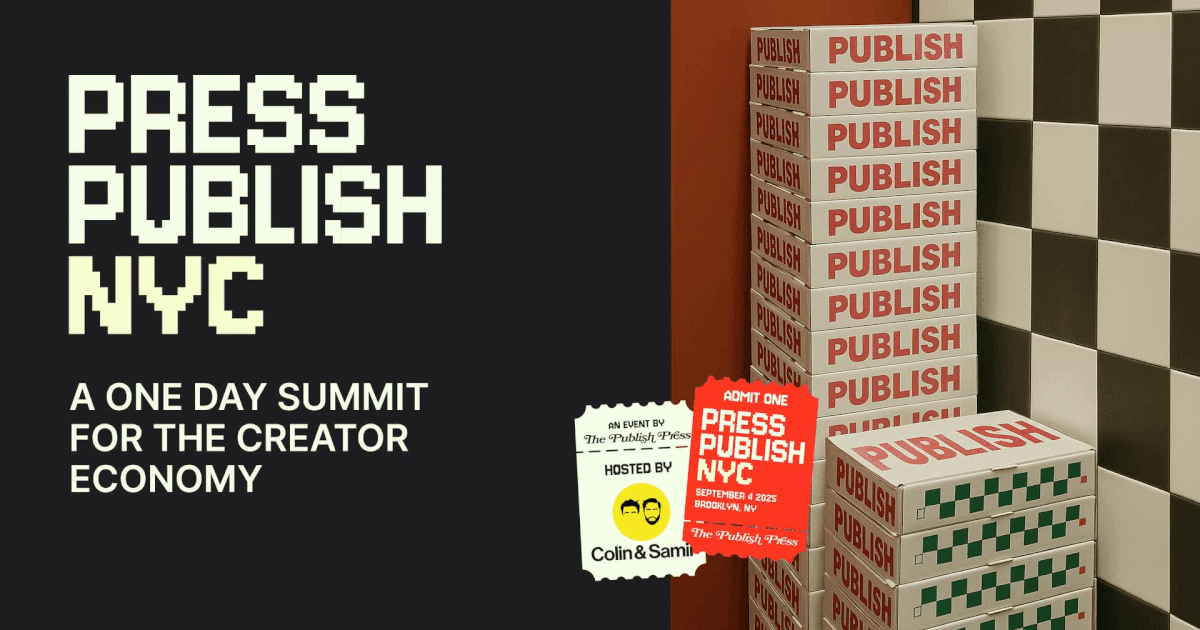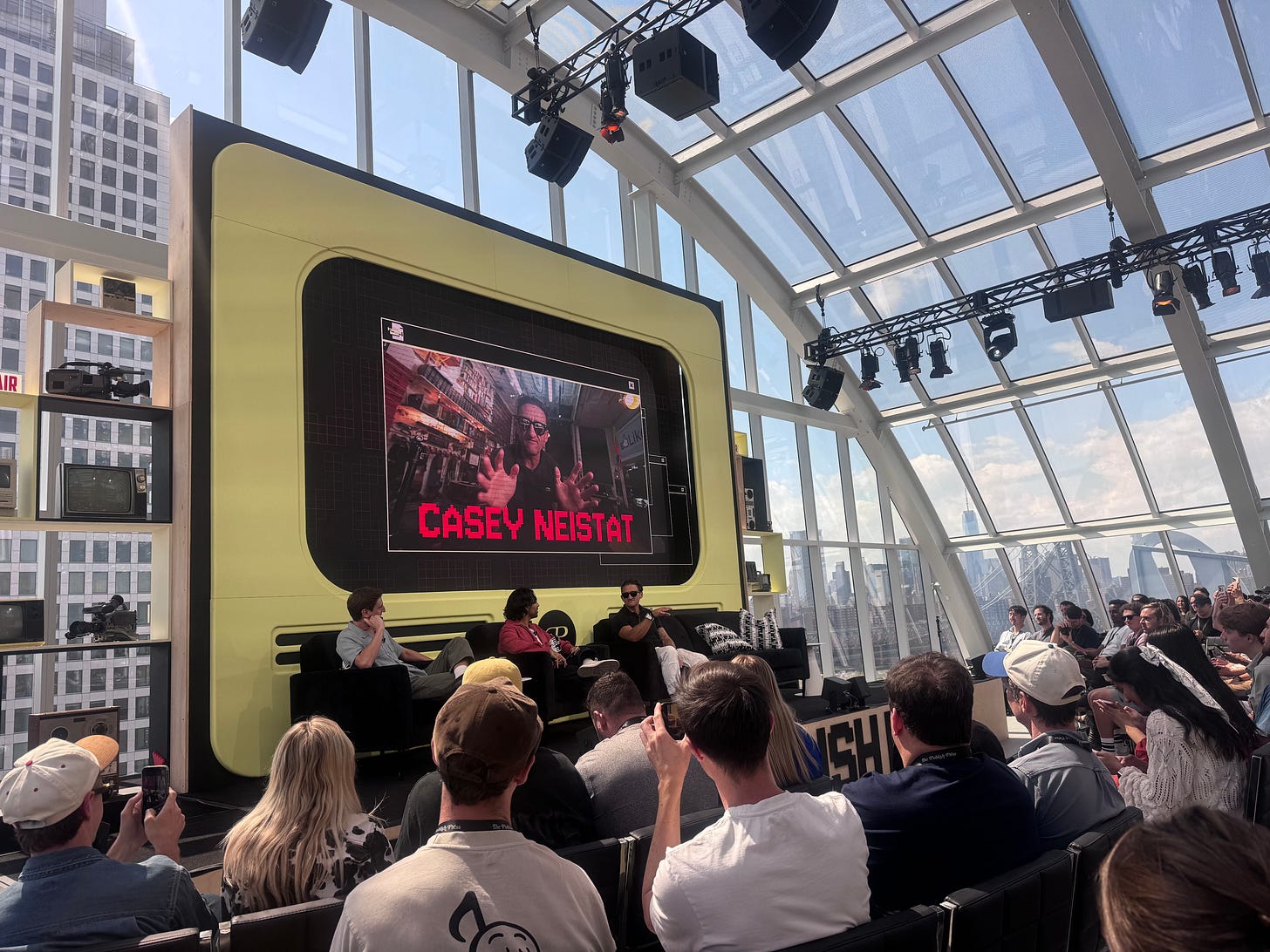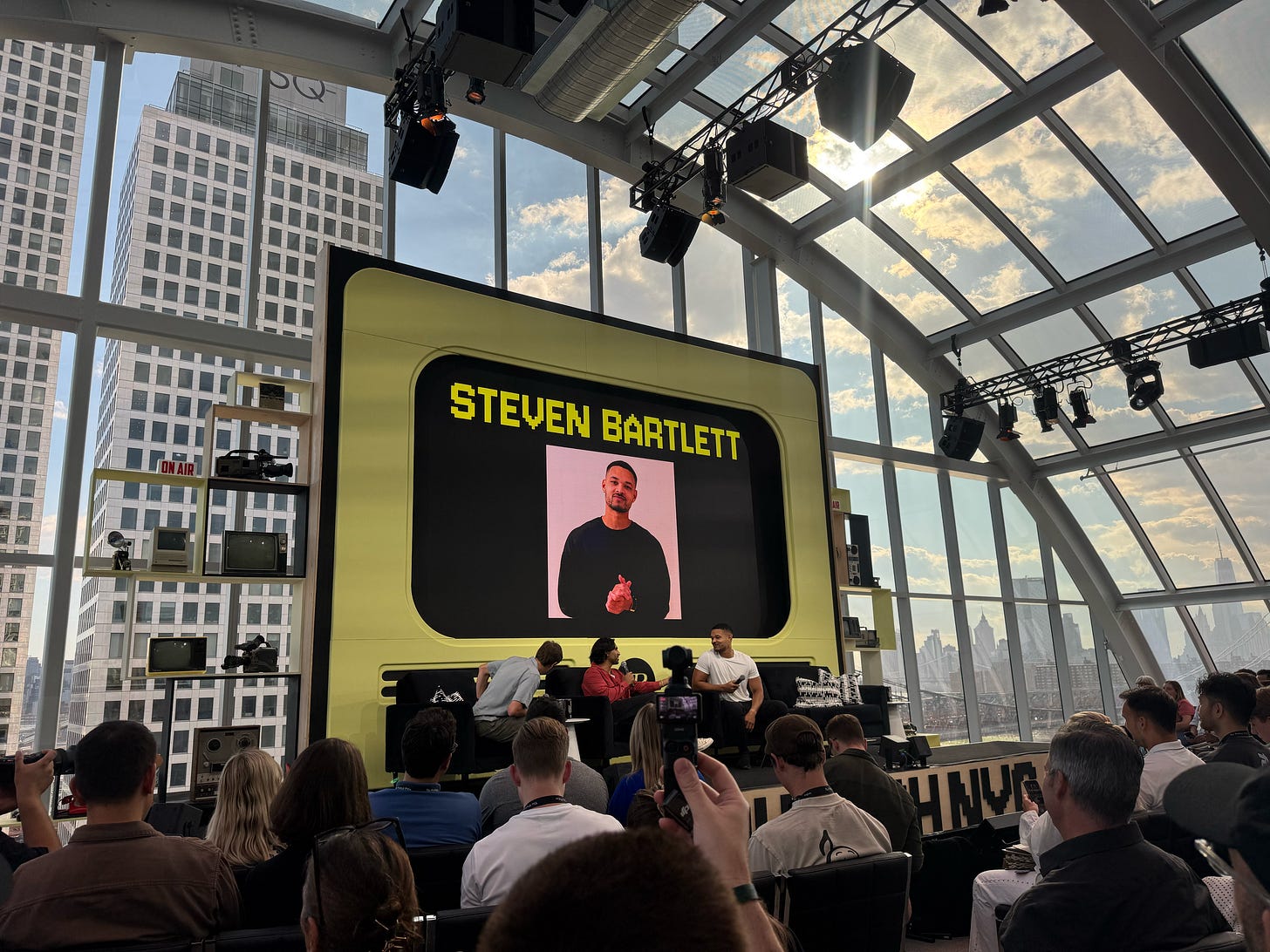Ok, I didn’t crash it. And I wouldn’t call this the “inner circle.” But now that I have your attention — I attended a creator event last week called Press Publish NYC.
As a Hollywood producer trying to shed the legacy mindset and lean into the creator economy, I didn’t know what to expect from Colin and Samir’s first Publish Press event in New York.
Here’s what it was: 400 people accepted out of 700 applicants with an evening of cocktails and dinner on a Virgin cruise ship in Manhattan and a full day of speakers and workshops at The Refinery in Brooklyn the next day. The crowd ranged from emerging creators building their first audiences, to managers of YouTube’s biggest stars, to investors, platform reps, and future-facing sponsors like Microsoft’s Co-Pilot.
So instead of a recap, here are my field notes—
Field Note #1: Access Is the Point
I pre-gamed. Weeks before the event, I stalked Colin and Samir’s LinkedIn posts about the upcoming event, combed the comments to see who was going, and reached out to people I thought might be interesting. I don’t love the pressure of cold networking, so I seeded allies ahead of time. One couple I found were building a full-stack backend platform for small and mid-sized creators. We grabbed coffee on the morning of the event, hit it off immediately, and agreed to alpha test their platform with our Mexico business.
That night, a large chunk of the invitees gathered on the new Virgin cruise ship at Pier 90. It was easy. Open. Accessible. No one was overdressed. No one was peacocking. Even creators with massive followings blended in—no red carpet, no press line, no hierarchy.
I ran into Chris Duncan, one of the founders of Creator Camp who I connected to when I wrote about their business a while back. He introduced me to a friend from the tech world. This guy had sold a couple of companies and now ran a community of brand-side creators and marketers. What struck me wasn’t the résumé—it was his approach. He wasn’t sketching business plans in a WeWork; he was testing ideas in motion, building while moving. He didn’t quite know what his next business would be but was circling something around tech and communities that I dont feel comfortable sharing here. He became my wingman for the night.
Then came the toast. Colin and Samir lifted their glasses and did what they do best—celebrating others, celebrating creativity. Samir pulled out his phone and explained that on the Virgin app, when you’re on their ship, you just shake it and someone shows up with champagne.
He demo’d it—and because this is the creator economy, Sir Richard Branson himself appeared with a bottle, pouring champagne straight into their mouths. Part spectacle, part savvy promotion.
Creators with a half a billion collective followers in the room were recording it on their phones. Whatever it cost—or didn’t cost—it was worth millions.
Sir Richard Branson standing next to Colin and Samir
Dinner followed. At my table: a Canadian creator just back from Kenya after delivering 300 pounds of donated hockey gear; a 25-year-old entrepreneur running podcast studios in Midtown and wrestling with how to launch his own shows and make them stand out in a world of infinite content.
The conversation drifted into the missing middle class of the creator economy—how everything clusters into either mega-studios or small niches. By the time I had wrapped up the event the next day I had crossed paths with amongst others….
A video editor from Nebula, talking about how scarce good editors are.
A couple of Twitch streamers, each with hundreds of thousands of followers, candid about the cycle of passion and burnout.
Several creator managers handling some of the biggest creators from around the globe…
A woman running the creator program for one of the world’s largest PR films.
A guy out of MIT who had studied entrepreneurship in developing countries and was now working at Whalar.
The Head of Creator Content for a major streaming platform
Most of the speakers at the event
This wasn’t networking. This was access. Flat. Democratic. The opposite of Hollywood, where the velvet ropes tell you exactly who you can and can’t talk to.
Field Note #2: Culture You Can Feel
First up on stage was Kevin Allocca, YouTube’s Global Director of Culture & Trends. His job is to map how two decades of uploads turned into the culture we all live inside.
Some of his data points hit hard:
47% of U.S. 14–24-year-olds say they’re part of a fandom no one they know in real life is in.
52% have watched content translated from another language. (MrBeast leaned hard into this, dubbing into Spanish, Portuguese, and beyond to expand globally.)
Gen Alpha is the first generation to watch content made by their own peers.
He showed the graph on video length — how it’s evolved (we’ve seen it before, but worth revisiting).
But the real punch wasn’t the numbers—it was the clips.
Kevin threaded the stats with the viral canon: Charlie Bit My Finger. Double Rainbow. OK Go’s zero-gravity video. Isaac Live Lip Dub Proposal. The Rick James’ “Tell me how you’re feeling” gotcha moment.
I’d seen them all before which was the point. So had everyone in the room—but always alone, on a laptop or phone. Experiencing them in a packed room, hundreds of people laughing and gasping together, was something else entirely.
For the first time, I didn’t just know the internet had become our cultural engine—I could feel it.
Field Note #3: Hollywood Isn’t the Villain
The surprise guest drove the point home: Casey Neistat. If you’re not steeped in creator lore, think of him as one of the godfathers of YouTube—an auteur with a camera who pioneered the vlog-as-cinema style. The kind of guy who can walk on stage in sunglasses (indoors) and get a standing ovation.
Casey’s take: he hates the phrase “creator economy.” When he started, it wasn’t about economy. It was about creativity. Hollywood, he argued, was the machine that stifled that impulse—which is why he left a blossoming career in LA for New York to build his own lane on Youtube.
But his advice to creators wasn’t to avoid Hollywood outright. It was: if you’re going to Hollywood, ask two questions—what are you bringing to the table, and what are they bringing? If it’s validation you want, stay home.
He pointed to Jimmy Donaldson—MrBeast, who Casey mentored—as the counterexample. Jimmy didn’t do an Amazon show for validation. He did it for bigger budgets, structured production, and access to an audience he didn’t already have. The right reason. And it worked.
Hollywood isn’t the villain here. It’s not the center either. It’s just another tool creators can choose to use—or not—on their own terms.
Field Note #4: Creators Are Founders
The next session paired Billy Parks (Slow Ventures) and Ashley Alexander (creator and founder of Nami Matcha).
Billy bets on creators the way VCs bet on startups: he looks for people who can pivot, take 1,000 no’s, and keep going. His view: creators who win understand their industries as much as they understand content.
Ashley proved the case study. With just a few million—but highly engaged—followers, she did $2.8M in year-one sales of matcha tea. How? By building with her audience: teasing the idea, sharing designs, asking for color feedback. By launch day, her fans didn’t feel like consumers. They felt like partners.
Later in the day, Mai Pham gave the other side of the spectrum. She’s built an empire on herself—vlogs, fashion lines, beauty brands, all while pulling millions of views. She’s exactly what Billy was talking about: not just a creator, but a founder running a diversified media company.
The throughline: creators are no longer talent waiting to be “discovered.” They are operators. Entrepreneurs. Founders.
Field Note #5: Copilot and the Memory Machine
Then came Mustafa Suleyman—Oxford dropout, co-founder of DeepMind, now EVP of Microsoft AI, overseeing Copilot. Black-and-white nails. Puffy parachute pants. Razor-sharp intellect. A rock star for the AI era.
He showed how he uses Copilot as a personal memory bank—uploading photos of meals, art, and moments, and letting the system tether context and recall it later in surprising ways.
Then he pushed it further as he waxed poetic about where entertainment could go: imagine a creator uploading clips or short films, and Copilot automatically stitching them into something new. A hybrid of captured content and connective fiction.
That’s where my brain went to neuroscience. We don’t actually recall original memories—we recall the last copy, rewritten each time to make sense of new moments. TikTok’s remix culture is already doing this at scale.
The implication: the next Game of Thrones might not be a scripted series at all. It might feel like an experience inside your own memories, constantly recalled and remixed. Your trip to Scotland might all of a blend with a dragon slaying mission and live in this sort of parallel memory bank you can access whenever you want.
And that wasn’t the scary part.
The scary part was Mustafa’s reminder: AI today is training on human-made videos. Soon it will train on the videos it creates itself. He doesn’t believe content has to be human to be compelling. To him, resistance is just a temporary obsession.
For a room full of creators, it was… maybe too interesting. You could feel people gaming out the scenarios: irrelevance, duplication, billions of synthetic realities. Not one Matrix. Billions.
Field Note #6: Iterate, Don’t Wait
The final surprise guest: Steven Bartlett, host of Diary of a CEO. If Casey is the auteur, Steven is the Tony Robbins of the creator generation—a Brit who grew up in the projects, started hustling with vending machines at 14, built and sold a digital agency for hundreds of millions, and now runs a media empire he recently turned down $100M for.
Steven’s lessons:
Better to win than be right. Today’s AI may not be good enough, but betting against where it’s headed is losing the future.
Fail often, fail fast. He built a Failure Team whose job is to test new businesses and fail as much as possible. Fear evaporates. Survivors have a better shot.
Sweat the small stuff. As an example he made iterative improvement in his podcast studio—better air fresheners, CO₂ monitors to stop “brain fog,” small optimizations that compound into better conversations.
Principles over moods. Emotions fluctuate, but discipline and principles drive better decisions.
Test before you drop. He built a platform for testing his video podcast which includes eye-tracking tests. Every podcast is tested with 2,000 community members before releasing episodes. Kind of using the old Hollywood playbook of test before release but fast and iterative and trained on his core audience.
And then the kicker: he had his Failure Team spend a year building an AI-only version of his podcast—his voice, his cadence, his brand. Result? The AI podcast had the same retention rates as the human one.
Taken with Mustafa’s musings, the message was clear: the future is coming faster than we want to admit.
Build for the moment. Change quickly. Pay attention.
Field Note #7: Why This, Why Now?
Creators are lonely. They usually work in isolation. The Lighthouse (which I’ve invested in and written about) solves that by building permanent campuses. Publish Press compliments this by pulling people in from across the country and world to create a finite, high-voltage moment.
And the timing matters. Creators know their value now. They’re having their moment. Events are popping up everywhere—but this one carried Colin and Samir’s curation, which gave it shape and authority.
Was it perfect? No. The room was hot. The acoustics were rough. But creators live in beta. And this was one hell of a beta test.









Wow! This sounds like it was an amazing event! I love the Richard Branson surprise! Such a classic
Good hanging w my wingman! More soon!!!